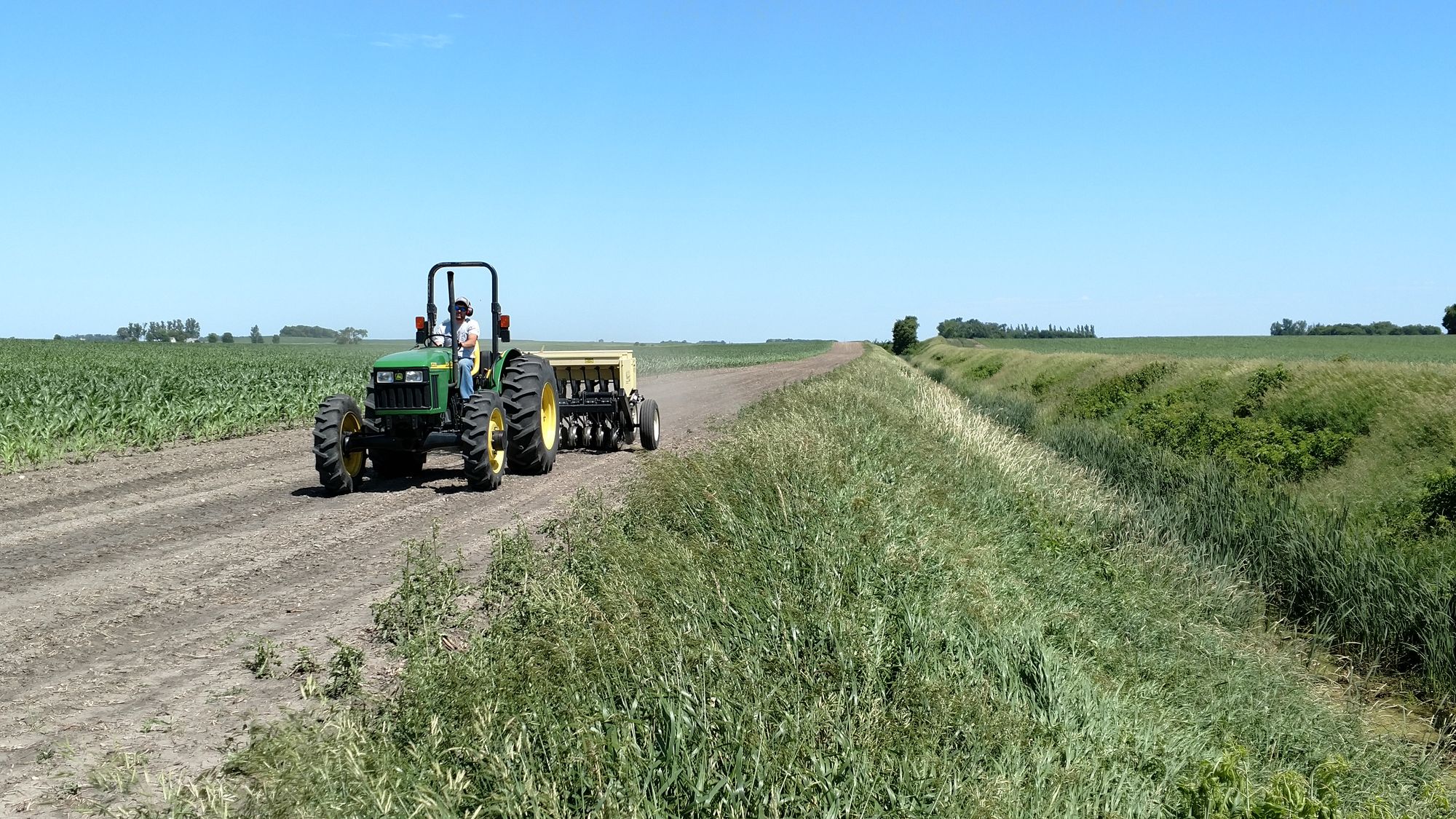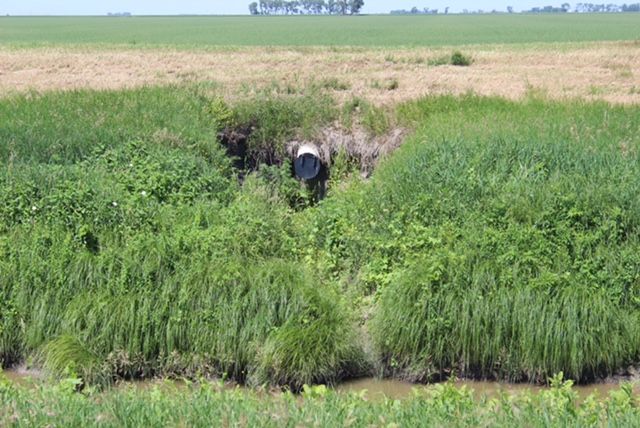As South Dakota and most other states rely on voluntary efforts by farmers to treat pollution and limit runoff – historically with only limited success – a new regulatory approach in Minnesota is showing that mandating water protection methods can make a significant difference.
A 2015 law that is now fully taking effect requires Minnesota farmers to install “buffer strips,” or wide swaths of hay or other grasses planted along waterways, that reduce runoff and limit release of harmful nutrients and pollutants into rivers and lakes.
The official who oversees implementation of the law said it has increased the use of buffer strips by nearly 20 percent in South Dakota’s neighbor to the east, with compliance as high as 99 percent along many rivers and lakes. A similar program that uses direct payments to Minnesota farmers who reduce runoff in environmentally sensitive areas has also attracted a high level of participation.
Agriculture officials, producers and some experts in South Dakota point to some success in the voluntary approach, including a high rate of no-till farming in the Missouri River valley that has reduced runoff and protected soil quality and erosion there. State agriculture officials insist that volunteer approaches can work, and that evidence of success can be contagious among farmers who want to reduce impacts on the environment.
In a statement to News Watch, interim South Dakota Agriculture Secretary Dustin Oedekoven said the voluntary and incentivized approach to reducing farm runoff and pollution works because state producers are committed to improving the environment.
“South Dakota’s farmers and ranchers care deeply about water quality and work hard every day to grow and raise food, feed and fuel for their families and families around the world while protecting natural resources,” wrote Oedekoven, who also serves as the state veterinarian.
“Voluntary programs, like the state’s buffer strip program or USDA’s Conservation Reserve Program or Conservation Stewardship Program, provide producers tools to help them establish and sustain practices on their operation that can protect and enhance water quality and other natural resources.”
And yet, the voluntary buffer strip program he mentioned drew 27 farmers who enrolled only 292 acres in 12 counties in its first year. Experts say the 40 percent tax break on land converted to buffer strips may not provide enough savings for most farmers to give up production on those lands along rivers and lakes.
Meanwhile, runoff from farms continues to pollute South Dakota rivers and lakes. About two-thirds of state rivers were deemed by the federal government as impaired due to pollution in 2017, with E.coli bacteria and total suspended solids from agricultural wastes the most common pollutants.
The stakes of improving agricultural operations are high in South Dakota.
Not only do 98 South Dakota municipalities use rivers as the source of their drinking water, but a recent study found genetic markers for potentially deadly forms of E.coli in the Big Sioux River and Rapid Creek that can sicken a human through ingestion of a single drop.
Enacting any mandatory agriculture runoff limits will be difficult in South Dakota, however, given the largely anti-regulatory sentiment in the state, according to one former lawmaker.
Former Democratic state senator Jim Peterson, a corn and soybean farmer from Revillo in Grant County, proposed the first voluntary buffer strip tax incentive program in South Dakota in 2016. The bill passed but was vetoed by Gov. Dennis Daugaard, who later proposed an amended buffer strip incentive program that is now law. Peterson, who said he employs numerous water and soil preservation methods on his farm, supports voluntary and incentivized approaches to encouraging improved practices. As a legislator, he also realized that requiring best practices in South Dakota was a long shot.
“I don’t think you’d ever get a mandate passed in the South Dakota Legislature, which is very conservative and where they always talk about how much they hate federal mandates,” said Peterson. “I really haven’t ever seen any mandates ever passed.”
Recent testing on Skunk Creek in eastern South Dakota revealed the ability of buffer strips to reduce pollutants in waterways. Based on testing done on the creek east of Colton in northern Minnehaha County, buffer strips reduced bacteria counts steadily as the creek flows toward the Big Sioux River. Tests taken on July 2 showed that 4,610 colony forming bacteria units were found in a stretch of creek without buffer strips. At each subsequent downstream testing site where buffer strips were in place, bacteria counts fell to 933, to 677 and to 504 at the most downstream test site.

Mandatory in Minnesota
The Minnesota mandatory buffer strip program has shown strong success so far, said Tom Gile, buffers and soil loss operations supervisor for the Minnesota Board of Water and Soil Resources, a state agency.
The law grew out of a summit on improving and protecting pheasant habitat and passed in 2015 with amendments added in two subsequent legislative sessions.
With some exceptions, particularly along lakes, the law requires buffer strips on any agricultural land along 41,500 miles of lakeshore, 33,700 miles of rivers and streams and 18,500 miles of public ditches.
The law requires buffer strips of a minimum of 30 feet and average of 50 feet along rivers and streams and 16.5 feet along ditches Compliance was required for rivers and lakes by Nov. 1, 2017 and drainage ditch compliance is required by Nov. 1, 2018.
Farmers are allowed in approved cases to reduce the buffer strip width if they employ other forms of runoff treatment or control or have other soil erosion protection measures in place, Gile said. Employing practices such as no-till or strip-till farming, planting cover crops or using side water inlets and berms to limit runoff and erosion can earn farmers the right to reduce buffer strip widths.
Throughout implementation of the law, employees of the Board of Soil and Water Resources have worked aggressively on public outreach and education to gain compliance without resorting to enforcement.
Local agricultural entities such as county soil and conservation boards are often the point of contact for farmers who have questions or want confirmation of compliance, Gile said. In some cases, letters outlining the law have been sent to producers. Some farmers have requested site visits by the state or local agencies to avoid violations, he said.
Aerial photos are taken to gauge compliance, and farmers who don’t comply are sent corrective action notices as an initial warning. If compliance is not gained within 11 months, fines of up to $500 can be issued monthly or even daily to offenders, he said.
No fines have been issued yet, Gile said, though after the initial 11-month grace period expires this fall, some fines are likely to be issued.
Gile said state and local officials hope to use education and peer pressure to gain compliance rather than resorting to fines.
Though the measure passed with bipartisan support in the Minnesota Legislature, the law is not without controversy or opposition, even at holiday dinners within Gile’s own family, which has a background in agriculture.
“It’s a law. Let’s not mince words, it is a regulatory program and there are certainly people who don’t like it, including members of my family who don’t like it but are subject to it,” Gile said.
So far, the program is credited with significantly heightening the use of buffer strips along Minnesota waterways, Gile said.
Prior to the law, compliance with voluntary buffer strip programs was estimated at about 80 percent, he said. Two full years after passage, Gile said surveys reveal 95 percent compliance with buffer strip guidelines on all waterways and 99 percent compliance specifically on qualifying lakes, rivers and streams.
“Minnesota is a huge state, it’s an extremely diverse state geographically, so as a whole, I’m really pleased with where we’re at today,” Gile said.
He credited state and local conservation staff members for diligence in educating and encouraging farmers, but also hails the producers themselves who have willingly or unwillingly taken steps to improve water quality in rivers, lakes and ditches.
“We want to provide some treatment for water that is flowing over the land and into the water bodies, and to be careful of what we’re doing to protect public waters,” he said. And yet, Gile added, “there’s still a lot of work to get to 99 and a half or 100 percent compliance.”
The state of Minnesota, where nearly half of state rivers and lakes are labeled as impaired by the federal government due to pollution, recently embarked on a separate major effort to reduce agricultural impacts in ecologically sensitive areas. The voluntary Conservation Reserve Enhancement Program began in January 2017 and allows for direct payments to farmers who engage in approved measures to treat and reduce runoff into waterways and to protect wetlands. The $500 million program – with $350 million from the U.S. Department of Agriculture and $150 million in state money – seeks to protect 60,000 acres of sensitive lands and waters and sources of drinking water.
Eighteen months into the effort, 154 landowners have qualified for payments for protecting about 5,700 acres of sensitive lands and waterways, according to state data.
"There are a lot of different approaches and two sides to these issues. I think some of the people that believe in a more regulatory approach, I'm not sure if they've actually walked in the shoes of a producer and understand the whole process." – Jeffrey Zimprich, conservationsit with USDA Natural Resources Conservation Service.
Some South Dakota successes
Without using mandates or money, encouraging South Dakota farmers to improve their land and water use relies on education and evidence-based science, agriculture experts say.
One way to prove to farmers that sustainable agriculture is beneficial is to first model the behavior and then distribute the results, according to Dwayne Beck, a scientist at the Dakota Lakes Research Farm.
The farm located about 17 miles east of Pierre on state Highway 34 was opened in 1990 and is a not-for-profit agricultural testing facility owned by area farmers and supported by donations. With the help of researchers from South Dakota State University, the farm is able to test farming practices and determine which are both friendly to the environment and beneficial to farmers’ bottom lines.
Beck said one major success story is how the farm used no-till practices to preserve soil, hold nutrients on the land longer and provide nitrogen for new crops all at the same time. In a no-till operation, farmers allow corn stalks or soybean plants to remain on the field after harvest, rather than plowing them into the soil. The remaining plants retain nitrogen and hold the soil firmly onto the fields, limiting runoff during fall rains or during the spring thaw.
Once area farmers were shown the financial benefits of no-till farming, and word spread, the region became a national leader in using no-till methods to protect area waterways, Beck said.
“If you look at what we got done here, we helped the farmers make more money while doing the right thing – and that’s the secret,” Beck said. “That’s opposed to making more money by doing the wrong thing.”
The next major goal is to encourage farmers to diversify their crops from season to season and year to year to further limit nutrient runoff and soil erosion, Beck said. Farmers who plant wheat or sunflowers in addition to corn and soybeans will see stronger harvests and improved water use as well as reduced losses from pests, Beck said.
“If you have diversity, you usually don’t have a lot of problems with any one insect or disease becoming a problem,” he said. “The thing we have right now is we have no diversity; we just have corn and soybeans so we have insects and diseases.”
The research farm benefited in its early years from a major downturn in the farm economy that had many farmers desperate for ways to improve processes, reduce fertilizer costs and increase outputs.
“We had a whole bunch of farmers who had to change something or they were going to go broke,” Beck said. “It’s sort of like, you don’t change your eating habits until your first heart attack.”
With nearly 1,000 acres in production, the farm is also able to scale up its methods and add legitimacy to its results, Beck said. Positive results from smaller research plots can easily be discounted by farmers who run far larger operations.
Educating farmers about best practices and making them comfortable and secure enough to try something new remains a challenge, but also provides the agriculture industry with opportunities, said Jeffrey Zimprich, the South Dakota conservationist with the USDA Natural Resources Conservation Service. Zimprich oversees a team of 240 federal employees who strive to help South Dakota farmers improve yields while also protecting the environment.
Eventually, Zimprich said, the main impetus for farmers to change or upgrade methods is likely to be money. Zimprich said he knows of instances where a banker suggested new land-use practices to a farmer after a different client saw success and increased revenue from the method.
“Some producers are driven to take care of the land, while some are curious and want to change but don’t know how, and then there are producers who don’t want to change,” Zimprich said. “But maybe the way to get to them is through higher profit margins.”

Reaching farmers on a local level
There may come a day when more regulations are needed, Zimprich said, but for now he believes farmers will lean toward improving practices without being threatened with fines.
“There are a lot of different approaches and two sides to these issues,” he said. “I think some of the people that believe in a more regulatory approach, I’m not sure if they’ve actually walked in the shoes of a producer and understand the whole process.”
On occasion, Zimprich and his team have taken small, hands-on steps to reach farmers who may not seek help on their own.
They recently distributed backpack-sized testing kits to farmers to help them track moisture depth after rainfalls. By providing farmers with an empirical way to test their own soil practices, Zimprich hopes more producers will see that best practices work.
Reaching more farmers may require greater efforts on the local level, according to Jay Gilbertson, head of the East Dakota Water Development District who encourages farmers to employ methods to reduce runoff and pollutants.
Gilbertson said the slow start to the state’s voluntary buffer-strip program is due to the low level of savings farmers receive for taking waterfront lands out of production. He estimated the savings for farmers could be as little as $5 to $10 per acre used as a buffer strip. Even on a large farm with a dissecting waterway, that doesn’t create much financial incentive, Gilbertson said.
“If you’re growing corn right up to the creek, you’re not going to change your practices to save $7 – you’re just not,” Gilbertson said. “A 40-percent tax break is significant, but if it only applies to a half-percent of the land you own, it won’t be much of a benefit.”
Still, Gilbertson supports the buffer strip program and remains hopeful that if more farmers begin to participate, it may have a domino effect that will lead to far more river and streams miles getting the protections.
Gilbertson, whose group aids in water protection and research in a 13-county area that includes Minnehaha County, believes that pressure from local agencies and advocates could encourage more participation. To that end, he is developing an effort to use money from his group – as little as $750 per county — to pay for administrative costs for county conservation districts to identify farmers who qualify for the tax incentives and reach out to them personally to encourage enrollment and installation of the buffer strips.
“The state program was left in the hands of the Department of Revenue, but I think the local county conservationists are the right people to jump-start the process because they know the people and the land,” Gilbertson said. “If I call a farmer personally and say, ‘Hey, I can lower your taxes,’ I’ll be somebody’s buddy by the end of that conversation.”
Zimprich said more time and effort – and especially more education and communication – are needed before abandoning a voluntary approach to improving farming practices in South Dakota.
“There’s no doubt that we have a way to go; we have improvements that can be made,” he said. “One key part of a voluntary approach is that it happens one producer at a time, one conversation at a time, one ecological practice at a time.”




